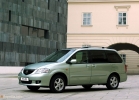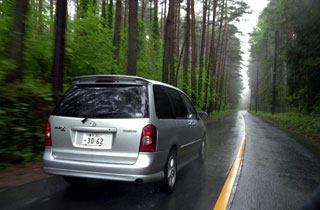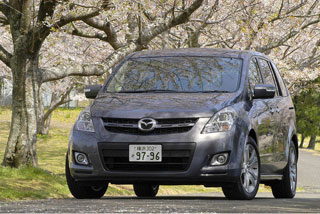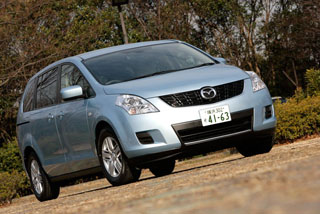Test drive Mazda MPV 1999 - 2006
Mazda with a belly
 A good car should be a lot apparently, they reasoned in Mazda and designed a new generation MPV mini-ven. And, you know, it worked! It was possible to create a worthy opponent popular in our Dodge Caravan market. True, something still restrains the spread of a large Mazda.
A good car should be a lot apparently, they reasoned in Mazda and designed a new generation MPV mini-ven. And, you know, it worked! It was possible to create a worthy opponent popular in our Dodge Caravan market. True, something still restrains the spread of a large Mazda. The history of Japanese minivans is very interesting. At first, the designers from the Land of the Rising Sun tried to offer this segment of the market something (universals with a high roof and ordinary swing doors; such was both Honda Shuttle / Odyssey and, in fact, Mazda MPV), but later they found a different path that turned out to be true . The Japanese went a beaten and proven road: we decided to play someone else's game according to other people's rules and surpass everyone. In this case, this meant to develop a mini-van in the image and likeness of American brands: a large, with shifting doors and three spacious rows of seats. This is exactly what Mazda MPV, released in 1999. (The car underwent two restyling, one small in 2002 and one deep, conducted in 2004. Just then a new, 2.3-liter engine appeared instead of the previous, 2-liter engine, and the old engines were once again seriously processed. ) And the Japanese really in many ways bypassed the Americans.
Some characteristics
Type of body mini-ven
The number of doors 5
Number of places 7
Length 4750 mm
Width 1830 mm
Height 1750 mm
Wheel base 2840 mm
Ground clearance -
Acceleration to 100 km/h* 14 s
Maximum speed* 180 km/h
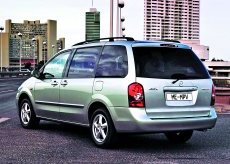 Outwardly, MPV is an ordinary American mini-wen with flat sides and a vertical stern, Mazda can be guessed in it only by a characteristic front. But by the reliability of the body, he will give one hundred points ahead of any Caravan (about low resistance to corrosion, as well as the latter's fogging optics). Rust can appear only as a result of poor -quality repairs after the accident, just like that on a factory paintwork, it will not occur under any circumstances (well, except with age). The only sore spot of this car of the wheels with which the rear doors are shifted: they break over time (which is, in principle, it is normal for mini-wen, because the load on them lies quite large). It is worth noting the protection of the power unit. The desired addition for MPV, since it is easy to hit the Carter's pallet or a high border.
Outwardly, MPV is an ordinary American mini-wen with flat sides and a vertical stern, Mazda can be guessed in it only by a characteristic front. But by the reliability of the body, he will give one hundred points ahead of any Caravan (about low resistance to corrosion, as well as the latter's fogging optics). Rust can appear only as a result of poor -quality repairs after the accident, just like that on a factory paintwork, it will not occur under any circumstances (well, except with age). The only sore spot of this car of the wheels with which the rear doors are shifted: they break over time (which is, in principle, it is normal for mini-wen, because the load on them lies quite large). It is worth noting the protection of the power unit. The desired addition for MPV, since it is easy to hit the Carter's pallet or a high border. 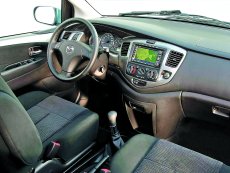 The car interior for many key indicators is impeccable: the equipment is rich, the upholstery of the seats is high -quality (either leather or velor, and right -handed specimens have a kind of alcantara). However, the materials of the finish leave a dual impression: say, the steering wheel is extremely pleasant to the touch, but for the sake of jokes to touch other surfaces, as you understand that the developers of the machine have saved (in the same Toyota materials of much better quality). But the possibilities of transforming the salon are no worse than the analogues: the middle series, for example, can be folded or completely pulled out of the car and leave in the garage. No, of course, claims and capacity. True, there are features in ergonomics that you will have to get used to: for example, the automatic transmission selector is made in an American manner in the form of a poker on a steering column.
The car interior for many key indicators is impeccable: the equipment is rich, the upholstery of the seats is high -quality (either leather or velor, and right -handed specimens have a kind of alcantara). However, the materials of the finish leave a dual impression: say, the steering wheel is extremely pleasant to the touch, but for the sake of jokes to touch other surfaces, as you understand that the developers of the machine have saved (in the same Toyota materials of much better quality). But the possibilities of transforming the salon are no worse than the analogues: the middle series, for example, can be folded or completely pulled out of the car and leave in the garage. No, of course, claims and capacity. True, there are features in ergonomics that you will have to get used to: for example, the automatic transmission selector is made in an American manner in the form of a poker on a steering column. And what about running qualities? In response, I would like to ask a counter question: what should they have a mini-wan? Well, the car is driving (the engines are quite powerful, and even if the 2-liter in-line four is jointed with the manual transmission, the MPV will still go more or less cheerfully), it will steer, albeit not like a passenger machine, but better than an average SUV. And in addition, it slows down (the front brake mechanisms migrated with some changes with Xedos 9)! In general, mini-wenes are not bought for annealing, but for measured and sedate driving. And in this role MPV is impeccable.
 MPV engines line are quite extensive. It begins with a familiar 626 GF in a row four with a volume of 2 l with a capacity of 140 liters. With. The problems remained the same as the Passenger Mazda: Carter's flowing pallets, noisy work, and a short -lived filter of rough fuel cleaning. There is also a diesel that experts do not complain due to the high cost of maintenance. In addition, spare parts for it are very difficult to buy, even to order. In general, it is better to bypass specimens with such a side motor. But the Ford V6 is what is needed, especially the 170-horsepower 2.5-liter engine. It is he who is considered a golden middle, although there is a more powerful, 203-horsepower 3-liter power unit. Although they also have sores: the oil flows from the pallet, as well as through the front oil seal. But the biggest problem is sensitivity to the amount of antifreeze and generally to the state of the cooling system: a serious failure can lead to overheating. And then the motor will have to be thrown into the trash, because there are simply no spare parts necessary for major repairs. Note that in 2002, in the V6 engines, instead of iron intake manifolds, they began to install plastic ones. In addition, some
MPV engines line are quite extensive. It begins with a familiar 626 GF in a row four with a volume of 2 l with a capacity of 140 liters. With. The problems remained the same as the Passenger Mazda: Carter's flowing pallets, noisy work, and a short -lived filter of rough fuel cleaning. There is also a diesel that experts do not complain due to the high cost of maintenance. In addition, spare parts for it are very difficult to buy, even to order. In general, it is better to bypass specimens with such a side motor. But the Ford V6 is what is needed, especially the 170-horsepower 2.5-liter engine. It is he who is considered a golden middle, although there is a more powerful, 203-horsepower 3-liter power unit. Although they also have sores: the oil flows from the pallet, as well as through the front oil seal. But the biggest problem is sensitivity to the amount of antifreeze and generally to the state of the cooling system: a serious failure can lead to overheating. And then the motor will have to be thrown into the trash, because there are simply no spare parts necessary for major repairs. Note that in 2002, in the V6 engines, instead of iron intake manifolds, they began to install plastic ones. In addition, some changes in the ignition system (instead of one coil, they began to put six, one for each cylinder). I must say that in the system of the old -sample, wires and candles serve for a long time (up to 5060 thousand km; however, it is recommended that the resource be replaced only by Motorcraft products), in a modernized ignition coil, they often out of order fail.
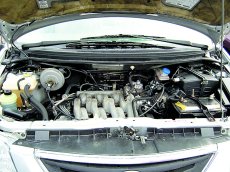 There are no complaints to the gearboxes (and they are automatic, and, oddly enough, mechanical): they go and go, ask to occasionally change the oil and go further and walk. By the way, in addition to front -wheel drive versions, there are all -wheel drive (though only in cars with the right wheel and a 2.5 liter engine), moreover, the full -wheel drive system is very interesting. The fact is that a semi-dependent twisting beam was left in the rear suspension, and the bridge was installed with two pennies independent from each other (which, in general, was strange, like some other mini-wenes, to make the rear suspension completely independent) .
There are no complaints to the gearboxes (and they are automatic, and, oddly enough, mechanical): they go and go, ask to occasionally change the oil and go further and walk. By the way, in addition to front -wheel drive versions, there are all -wheel drive (though only in cars with the right wheel and a 2.5 liter engine), moreover, the full -wheel drive system is very interesting. The fact is that a semi-dependent twisting beam was left in the rear suspension, and the bridge was installed with two pennies independent from each other (which, in general, was strange, like some other mini-wenes, to make the rear suspension completely independent) . The suspension design is completely simple, and with normal operation it does not have demolition, respectively,
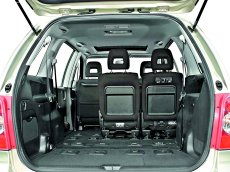 for a long time, nothing needs to be changed in it. True, on our roads, individual details nevertheless emit the spirit ahead of time: for example, to a run of 50 thousand km. Famous supports often fail (and all 100 thousand km can pass). But almost all other details of the shock absorbers, racks and bushings of the pine stability stabilizer will withstand 100 thousand km and will feel quite cheerful. They are pleasing with the resource and brakes: the front ones with two -piston calipers (almost the same were placed on the Mazda Xedos 9, and on the Toyota Mark II with a turbo engine), the rear drum (by the way, drum brakes rarely require attention). Note that when replacing the front pads, it is advisable to rearrange the so -called squeaks from old pads to new ones, because they usually do not enter the kit, but to determine the degree of wear of the pads without these squeaks
for a long time, nothing needs to be changed in it. True, on our roads, individual details nevertheless emit the spirit ahead of time: for example, to a run of 50 thousand km. Famous supports often fail (and all 100 thousand km can pass). But almost all other details of the shock absorbers, racks and bushings of the pine stability stabilizer will withstand 100 thousand km and will feel quite cheerful. They are pleasing with the resource and brakes: the front ones with two -piston calipers (almost the same were placed on the Mazda Xedos 9, and on the Toyota Mark II with a turbo engine), the rear drum (by the way, drum brakes rarely require attention). Note that when replacing the front pads, it is advisable to rearrange the so -called squeaks from old pads to new ones, because they usually do not enter the kit, but to determine the degree of wear of the pads without these squeaks 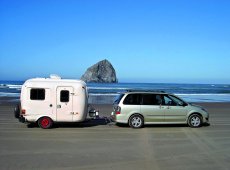 it is difficult enough (especially if steel wheels are installed on the machine).
it is difficult enough (especially if steel wheels are installed on the machine). In general, MPV gives the impression of a very competently and correctly designed car. He has a normal appearance, a pleasant salon in all respects, a high level of comfort, besides, the car is hostile: to kill it, you will have to try hard. However, not so perfect Caravan is still much more popular. What is the matter? And everything rests on the price: MPV is much more expensive than American competitors. In addition, the Japanese woman has a more sacred device, and hence the laborious and expensive maintenance. Although this can be reconciled with this: MPV rarely gives reasons for appeals to a car service.
The advantages and disadvantages of the model
Advantages
Spacious salon
Reliable suspension
High level of comfort
Flaws
There is no elongated version
Inexpensive decoration materials
A few clumsy design



